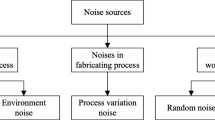Abstract
Due to the globalization of integrated circuit design and manufacturing, hardware Trojan has become a serious security threat. In this paper, we decompose redundant thermal maps to extract Trojan activity factor using factor analysis to implement hardware Trojan detection and location. Xilinx FPGAs configured with the benchmark circuits from Trust-hub are utilized to evaluate our proposed countermeasure. The results indicate that hardware Trojans with less than 20 gates can be detected.








Similar content being viewed by others
References
Agrawal D, Baktir S, Karakoyunlu D, Rohatgi P, Sunar B (2007) Trojan detection using IC fingerprinting. In: 2007 IEEE symposium on security and privacy, Berkeley, pp 296–310
Carikli DG, Blanc M (2018) The intel management engine: an attack on computer users? freedom. Free software foundation. https://www.fsf.org/blogs/sysadmin/the-management-engine-an-attack-on-computer-users-freedom
Cha B, Gupta SK (2012) Efficient Trojan detection via calibration of process variation. In: 2012 IEEE 21st Asian test symposium, Niigata, pp 355–361
Chakraborty RS, Wolff F, Paul S (2009) MERO: a statistical approach for hardware Trojan detection. Lect Notes Comput Sci 5747:396–410
He JJ, Zhao YQ, Guo XL, Jin Y (2017) Hardware Trojan detection through chip-free electromagnetic side-channel statistical analysis. IEEE Transactions on Very Large Scale Integration Systems 25:2939–2948
Jin Y, Makris Y (2008) Hardware Trojan detection using path delay fingerprint. In: 2008 IEEE international workshop on hardware-oriented security and trust, Anaheim, pp 51–57
Li J, Lach J (2008) At-speed delay characterization for ic authentication and Trojan horse detection. In: IEEE international workshop on hardware-oriented security and trust, Anaheim, pp 8–14
Lin N, Li SQ, Chen JH, Wei P, Zhao ZX (2014) The influence on sensitivity of hardware Trojan detection by test vector. In: 2014 communications security conference, Bejing, pp 1–6
Liu Y, Jin Y, Makris Y (2013) Hardware Trojans in wireless cryptographic ICs: silicon demonstration & detection method evaluation. In: 2013 IEEE/ACM international conference on computer-aided design, San Jose, pp 399–404
Liu Y, Volanis G, Huang K, Makris Y (2015) Concurrent hardware Trojan detection in wireless cryptographic ICs. In: 2015 IEEE test conference, Anaheim, pp 1–8
Liu C, Patrick C, Yang CG (2016) A mutual auditing framework to protect IoT against hardware Trojans. In: 2016 21st Asia and South Pacific design automation conference, pp 69–74
Nowroz AN, Hu KQ, Koushanfar F, et al. (2014) Novel techniques for high-sensitivity hardware Trojan detection using thermal and power maps. IEEE Trans Comput Aided Des Integr Circuits Syst 33:1792–1805
Salmani H, Tehranipoor M (2012) Layout-aware switching activity localization to enhance hardware Trojan detection. IEEE Trans Inf Forensics Secur 7:76–87
Salmani H, Tehranipoor M (2018) Trust-hub. https://www.trust-hub.org
Shen G, Tang YK, Li SQ, Chen JH, Yang BB (2017) A general framework of hardware Trojan detection: two-level temperature difference based thermal map analysis. In: 2017 11th IEEE international conference on anti-counterfeiting, security and identification, Xiamen, pp 172–178
Soll O, Korak T, Muehlberghuber M, Hutter M (2014) EM-based detection of hardware Trojans on FPGAs. In: 2014 IEEE international symposium on hardware-oriented security and trust, Arlington, pp 84–87
Tehranipoor M, Koushanfar F (2010) A survey of hardware Trojan taxonomy and detection. IEEE Design & Test of Computers Magnetism 27:10–25
Wang RX (1986) Mathematical statistics. Xi’an Jiaotong University Press, Xi’an, pp 32–109
Zhang JL, Fang L, Li L, Zhang ZX (2015) A novel approach to detecting hardware Trojan horses. In: 2015 8th international symposium on computational intelligence and design, Hangzhou, pp 43–46
Zhao ZX, Ni L, Li SQ, Shi YB (2015) A feature extraction method for hardware Trojan detection. In: 2015 international conference on automation, mechanical control and computational engineering, Jinan, pp 1726–1731
Zhou B, Zhang W, Thambipilai S (2016) Cost-efficient acceleration of hardware Trojan detection through fan-out cone analysis and weighted random pattern technique. IEEE Trans Comput Aided Des Integr Circuits Syst 35:792–805
(2010) Partan-3A FPGA family: data sheet
(2018) Law of large numbers. https://en.wikipedia.org/wiki/Law_of_large_numbers
Author information
Authors and Affiliations
Corresponding author
Additional information
Responsible Editor: P. Mishra
Publisher’s Note
Springer Nature remains neutral with regard to jurisdictional claims in published maps and institutional affiliations.
Rights and permissions
About this article
Cite this article
Tang, Y., Fang, L. & Li, S. Activity Factor Based Hardware Trojan Detection and Localization. J Electron Test 35, 293–302 (2019). https://doi.org/10.1007/s10836-019-05803-1
Received:
Accepted:
Published:
Issue Date:
DOI: https://doi.org/10.1007/s10836-019-05803-1




